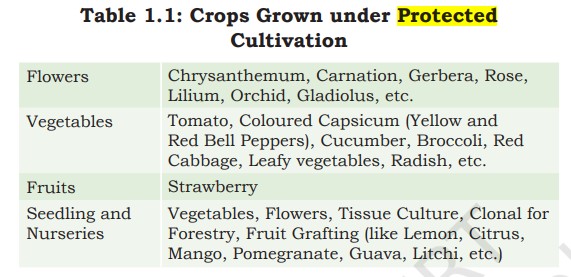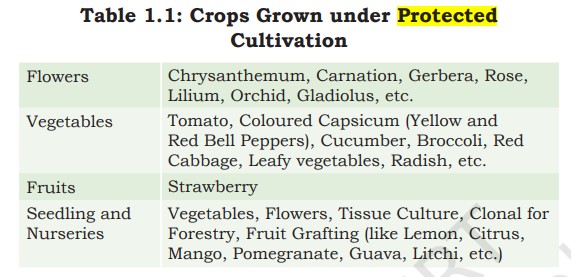CURRENT AFFAIRS
Get the most updated and recent current affair content on Padhaikaro.com
Protected cultivation
- Vaid's ICS, Lucknow
- 02, May 2022

Why in News?
Recently ,the importance of Protected cultivation was highlighted .
What is Protected cultivation?
- It is a process of growing crops in a controlled environment which means that the temperature, humidity, light and such other factors can be regulated as per requirement of the crop.
This assists in a healthier and larger production.
- It offers a massive potential to shorten and optimise farm-to-plate supply chains by making food available closer to the consumer and thereby can go a long way to improve the nation’s GDP and reduce imports dependency.
- It gives opportunities for the cultivation of horticultural crops in an entrepreneurial form for the upmarkets in urban and semi-urban areas.
- At present in India, the small and medium farmers have started flower and vegetable cultivation under different types of modular protected structures depending upon their investment capacity and availability of market in their area.

Objectives of Protected Cultivation
- Protection of plants from abiotic stress (physical or by non-living organism) such as temperature, excess/deficit water, hot and cold waves, and biotic factors such as pest and disease incidences, etc
- Efficient water use with minimum weed infestation.
- Enhancing productivity per unit area.
- Minimising the use of pesticides in crop production.
- Promotion of high value, quality horticultural produce.
- Propagation of planting material to improve germination percentage; healthy, uniform, disease free planting material and better hardening.
- Year-round and off-season production of flower, vegetable or fruit crops.
- Production of disease-free and genetically better transplants.
Limitations of Protected Cultivation
- High cost of initial infrastructure (capital cost).
- Non-availability of skilled human power and their replacement locally.
- Lack of technical knowledge of growing crops under protected structures.
- All the operations are very intensive and require constant effort.
- Requires close supervision and monitoring.
- A few pests and soil-borne pathogens are difficult to manage.
- Repair and maintenance are major hurdles.
- Requires assured marketing, since the investment of resources like time, effort and finances, is expected to be very high.
Schemes for protected cultivation
- The Government of India executes various schemes for protected cultivation at the central and the state levels to popularise these high-tech plant growing techniques.
- National agencies through their leading schemes viz.
- National Horticulture Board (NHB), National Horticulture Mission (NHM), Mission for Integrated Development of Horticulture (MIDH)
- Rashtriya Krishi Vikas Yojana(RKVY) creates awareness and provides financial support to the farmers, so that protected farming for high value horticultural crops could be adopted easily.
Way Forward
- Protected cultivation has the potential to create new jobs, skill sets, and economic opportunities for the agriculture students of our country, who are seen to be able to adapt and move forward with the learning curve quickly.
- If agricultural universities and students are able to capitalise on this, the market is bound to grow significantly and explode with new job opportunities alongside chartering new ground-level innovations and pathways to further develop our agri-economy in the years to come.
- The positive impact on the circular economy particularly with vertical farming methods like cocoponics (by upcycling agricultural residues into compost and thus creating value out of it) has the potential to create new revenue streams and income opportunities, especially for farmers living near wastelands or marginal rural areas and in mitigating the soil degradation problem of India’s rural economy..
Additional Information
History
Hydroponics:
Aeroponics:
Aquaponics:
|
FACTS FOR PRELIMS:
‘Lucy’ Mission:
Launched in October 2022, this is NASA’s first mission to explore the Jupiter Trojan asteroids.
- It is a solar-powered mission.
- It is estimated to be over 12 years long, during the course of which the spacecraft will visit eight asteroids covering a distance of about 6.3 billion km to deepen the understanding of the “young solar system”.
Aim of the mission:
The mission is designed to understand the composition of the diverse asteroids that are a part of the Trojan asteroid swarms, to determine the mass and densities of the materials and to look for and study the satellites and rings that may orbit the Trojan asteroids.